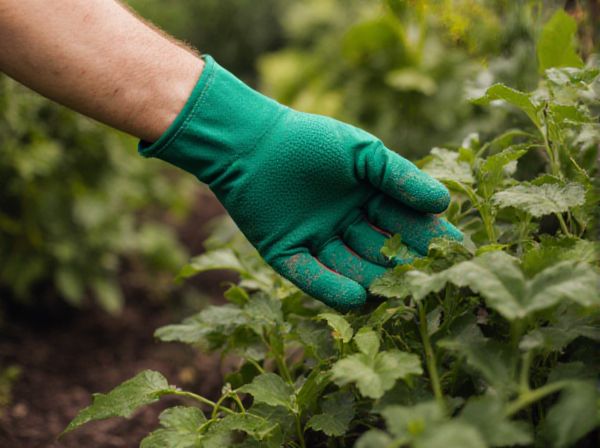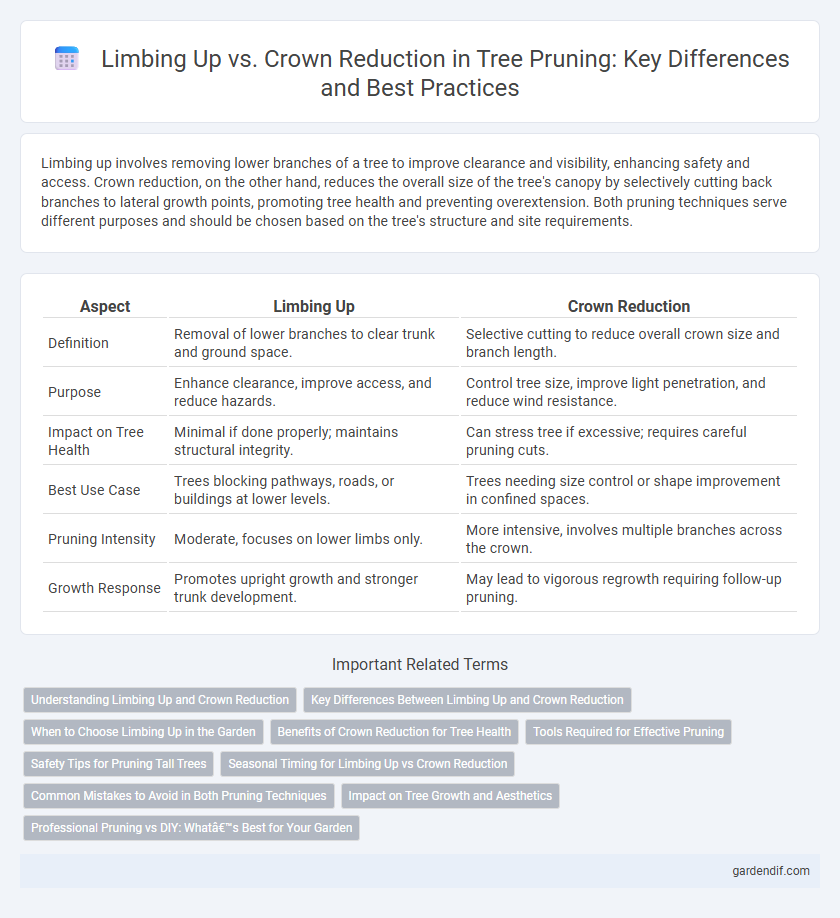
Limbing Up vs Crown Reduction Illustration
Limbing up involves removing lower branches of a tree to improve clearance and visibility, enhancing safety and access. Crown reduction, on the other hand, reduces the overall size of the tree's canopy by selectively cutting back branches to lateral growth points, promoting tree health and preventing overextension. Both pruning techniques serve different purposes and should be chosen based on the tree's structure and site requirements.
Table of Comparison
| Aspect | Limbing Up | Crown Reduction |
|---|---|---|
| Definition | Removal of lower branches to clear trunk and ground space. | Selective cutting to reduce overall crown size and branch length. |
| Purpose | Enhance clearance, improve access, and reduce hazards. | Control tree size, improve light penetration, and reduce wind resistance. |
| Impact on Tree Health | Minimal if done properly; maintains structural integrity. | Can stress tree if excessive; requires careful pruning cuts. |
| Best Use Case | Trees blocking pathways, roads, or buildings at lower levels. | Trees needing size control or shape improvement in confined spaces. |
| Pruning Intensity | Moderate, focuses on lower limbs only. | More intensive, involves multiple branches across the crown. |
| Growth Response | Promotes upright growth and stronger trunk development. | May lead to vigorous regrowth requiring follow-up pruning. |
Understanding Limbing Up and Crown Reduction
Limbing up involves the selective removal of lower branches to improve visibility, access, and safety without significantly altering the tree's overall structure. Crown reduction, on the other hand, entails cutting back the upper portions of the tree's canopy to reduce height and spread while maintaining the tree's natural shape. Understanding these pruning techniques helps in choosing the appropriate method for tree health, aesthetics, and structural integrity.
Key Differences Between Limbing Up and Crown Reduction
Limbing up involves the selective removal of lower branches to elevate the tree canopy, improving clearance and access while maintaining the overall tree structure. Crown reduction focuses on decreasing the size of the tree's canopy by cutting back branches to lateral growth points, which helps control tree height and spread without compromising stability. Key differences include the purpose--limbing up enhances clearance, whereas crown reduction controls size--and the extent of branch removal, with crown reduction being more intensive and affecting the tree's silhouette.
When to Choose Limbing Up in the Garden
Limbing up is ideal when the goal is to remove lower branches to improve access, increase sunlight exposure, and enhance air circulation around the trunk in a garden setting. This technique helps prevent potential safety hazards by clearing pathways and reduces the risk of pest infestations by promoting healthier tree structure. Gardeners should choose limbing up when the focus is on structural clearance rather than size reduction, which is better addressed by crown reduction.
Benefits of Crown Reduction for Tree Health
Crown reduction improves tree health by decreasing branch weight and reducing wind resistance, minimizing the risk of limb breakage and structural damage. This method enhances air circulation and sunlight penetration throughout the canopy, promoting overall vitality and reducing disease susceptibility. Compared to limbing up, crown reduction preserves the tree's natural shape and balance, supporting long-term growth stability.
Tools Required for Effective Pruning
Effective pruning requires selecting proper tools suited to the specific task: limbing up demands sturdy pruning saws or pole pruners to remove heavy limbs safely, whereas crown reduction benefits from sharp bypass pruners and loppers for precise cuts on smaller branches. Utilizing tools with ergonomic handles and high-carbon steel blades enhances cutting efficiency and reduces tree stress during both limbing up and crown reduction. Regular sharpening and disinfecting of pruning tools prevent damage to the tree and minimize the risk of disease transmission.
Safety Tips for Pruning Tall Trees
When pruning tall trees, limb up by removing lower branches to create a safe working zone and improve visibility, reducing the risk of falling debris. Crown reduction minimizes tree height and canopy spread but requires careful assessment of weight distribution to avoid limb failure. Always use proper safety equipment, ensure stable footing or harness use, and avoid working alone to prevent accidents during pruning operations.
Seasonal Timing for Limbing Up vs Crown Reduction
Limbing up is best performed during late dormancy or early spring to promote healthy wound closure and reduce stress on the tree. Crown reduction is typically done in late summer or early fall to minimize sap loss and decrease the risk of pest infestation. Proper seasonal timing for each pruning method ensures optimal tree health and structural integrity.
Common Mistakes to Avoid in Both Pruning Techniques
Common mistakes in limbing up include removing too many lower branches at once or cutting close to the trunk, which can cause stress and increase susceptibility to disease. In crown reduction, improper cuts that leave large stubs or remove excessive branch length can lead to weak regrowth and structural instability. Avoiding these errors ensures healthy tree development and maintains structural integrity.
Impact on Tree Growth and Aesthetics
Limbing up removes lower branches to improve access and increase light penetration, promoting healthier growth and enhancing the tree's natural shape. Crown reduction cuts back the outer edges of the canopy, controlling size but potentially causing stress and altering the tree's aesthetic balance. Both methods affect photosynthesis differently, with limbing up maintaining structural integrity while crown reduction may lead to denser foliage and slower recovery.
Professional Pruning vs DIY: What’s Best for Your Garden
Professional pruning of limbing up ensures precise removal of lower branches to improve tree health and safety, while crown reduction requires expert skill to maintain tree structure and avoid damage. DIY pruning attempts often risk improper cuts that can lead to disease, poor growth, or aesthetic issues, especially with complex techniques like crown reduction. Hiring certified arborists guarantees adherence to best practices and long-term garden vitality, making professional pruning the superior choice for limb management and crown shaping.
Limbing Up vs Crown Reduction Infographic

 gardendif.com
gardendif.com